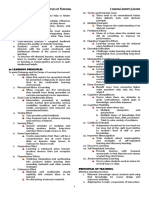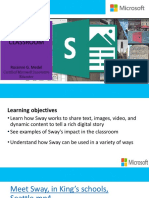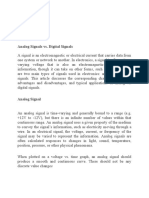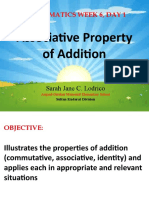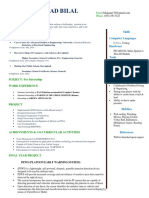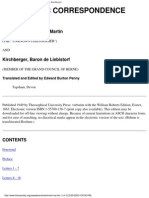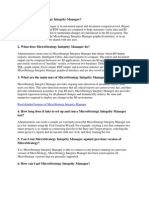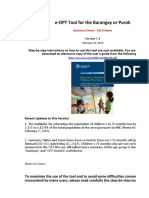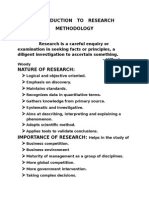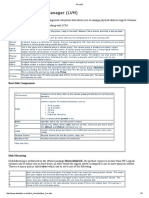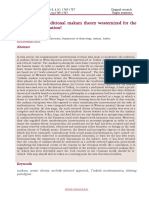Multimedia Learning
Multimedia Learning
Uploaded by
Gualter PaisCopyright:
Available Formats
Multimedia Learning
Multimedia Learning
Uploaded by
Gualter PaisCopyright
Available Formats
Share this document
Did you find this document useful?
Is this content inappropriate?
Copyright:
Available Formats
Multimedia Learning
Multimedia Learning
Uploaded by
Gualter PaisCopyright:
Available Formats
MULTIMEDIA LEARNING: A NEW PARADIGM IN EDUCATION by Ms. Neo Mai* and Mr.
Ken Neo TK* ABSTRACT Since the PC (personal computer) was first introduced in the 1970s, its processing power has progressed by leaps and bounds. The PC is now able to process the multimedia elements as well as become a communication device. With this advancement, the Information and Communication Technology (ICT), particularly the multimedia technology, has rapidly permeated and increasingly altered the landscape in the educationa l arena. In this paper, we focus on using multimedia as a strategic instructional media and the infusion of ICT and the multimedia technology into education which has created an impact on the traditional instructional communication process (ICP). This has led to a new paradigm in education and the evolution of new concepts in content development and a number of innovative methods in which information can be communicated to the learners. This new learning environment will undoubtedly influence the way teachers teach and students learn. INTRODUCTION The ICT (Information and Communication Technology) revolution is fast changing the world, and creating a generation that is media-hungry and technologically savvy. This new generation is using digital media for learning and communicating (Tapscott, 1998). Business, industry, the military and educational institutions have recognised this potential and used computers as instructional tools. However, in the context of education, technology also refers to the process of applying the tools for educational purposes. In other words, educational technology is a combination of the processes and tools involved in addressing educational needs and problems, with an emphasis on applying the most current tools: computers and their related technologies (Roblyer and Edwards, 2000). The advent of multimedia and multimedia technologies has changed the way educators teach and students learn. With multimedia, the communication of the information can be done in a more effective manner and it can be an effective instructional medium for delivering information. Multimedia application design offers new insights into the learning process of the designer and forces him or her to represent information and knowledge in a new and innovative way (Neo and Neo, 2000). The use of multimedia as a platform for teaching is made even more possible with the availability of the MPCs (Multimedia PCs) that are powerful, fast, and able to process all media elements effortlessly and quickly, and multimedia software packages that are user- friendly yet power-packed. * Centre for Innovative Education (CINE) Faculty of Creative Multimedia, Multimedia University, Cyberjaya, Malaysia, kneo@pc.jaring.my. Multimedia provides a means to supplement a presenters efforts to garner attention, increase retention, improve comprehension, and to bring an audience into agreement, which consequently results in people remembering 20% of what they see, 40% of what they see and hear, but about 75% of what they see and hear and do simultaneously (Lindstrom 1994). MULTIMEDIA AS A TEACHING AND LEARNING TOOL In the traditional information communication process (ICP), the teacher is the source of the knowledge and presents the knowledge to the students, who are in turn, passive receivers of the information. With multimedia, the communication of the information can be done in a more effective manner and it can be an
effective instructional medium for delivering educational information. This is because it enables the teacher to represent the information in various media, i.e., via sound, text, animation, video and images. With multimedia, the teacher is now the director of the knowledge and can use the various combinations of media elements to create interactive educational content. The result is a stimulating environment for learning and retaining the information delivered. The marriage of content and multimedia technology results in interactive multimedia materials which can be delivered to the students in teacher-centered, student-centered, or mixed teaching and learning modes (Figure 1). Figure 1. Using multimedia to represent content and delivering via various methods In the teacher-centered mode, the teacher is the one in control of the information that is received by the students and is responsible for how much information is being disseminated to them. The teacher-centred methods include presentations and demonstrations to process the information. Students are also able to retain and recall the information as well as obtain mastery in the subject matter with drills and practices, and tutorials, which are highly interactive. The multimedia courseware can also be packaged on the CD-ROM and delivered in a networked classroom leading to a teacher-centered mode where the courseware is opened on their PCs and the students follow the teachers lecture on their PCs. In the student-centered method, the students construct their own knowledge and bring their authentic experiences into the learning process with the teacher as the facilitator. The multimedia courseware content can also be packaged as a Web file and delivered on the Internet in a Web browser can result in online courses where the students access the courseware from a browser on their PCs. The student is then free to engage in learning on his or her own time and pace, and consequently, the learning mode is student-centered. This multimedia material can be used to foster team-processing and active learning as with collaborative and cooperative methods. This encourages higher- level learning, increases comprehension and retention rates, and focuses on the total development of the student in self-accessed and self-directed learning. In the mixed mode, the teacher has the flexibility to incorporate the two teaching and learning approaches whenever they deem them useful, to increase and enhance their students learning processes. Here, the same multimedia courseware content can also be packaged and delivered over satellite and broadband technologies for distance learning. Here, the student learns the materials on his or her own time and pace, and interacts with the teacher via video-conferencing in real-time. CONCLUSION There is little doubt that the changing role of education is currenly being reinforced with the integration of multimedia technologies. This has led to a new paradigm in education and the evolution of new concepts in content development and a number of innovative methods in which information can be communicated to the learners. This new learning environment will undoubtedly influence the way teachers teach and students learn. REFERENCES Lindstrom, R. (1994). The Business Week Guide to Multimedia Presentations: Create Dynamic Presentations That Inspire. McGraw-Hill, New York. Neo, M & Neo, T. K. (2000). Multimedia Learning: Using multimedia as a platform for instruction and learning in higher education. Proceedings of
the Multimedia University International Symposium on Information and Communication Technologies 2000 (M2USIC2000), PJ Hilton, October 5-6, 2000, pp S3-1.1 - 1.4. Roblyer, M.D. and Edwards, J. (1998). Integrating Educational Technology into Teaching (second edition). Merrill/Prentice-Hall, New Jersey. Tapscott, D. (1998). Growing Up Digital: The Rise of the Net Generation. McGraw-Hill, New York. APRENDIZAGEM MULTIMDIA: UMA NOVO PARADIGMA EM EDUCAO pela Sra. Neo Mai * e o Sr. Ken Neo TK * ABSTRACT Uma vez que o PC (personal computer) foi introduzido pela primeira vez na dcada de 1970, seu processamento poder progrediu aos trancos e barrancos. O PC agora capaz de processar o elementos multimdia, bem como tornar-se um dispositivo de comunicao. Com isso avano, informaes e tecnologias de comunicao (TIC), particularmente a tecnologia multimdia, tem permeado rapidamente e cada vez mais alterou a paisagem na arena de l de educao. Este papel, vamos nos concentrar em usando multimdia como uma mdia instrucional estratgica e a infuso das TIC e a tecnologia multimdia em educao que criou um impacto sobre a processo de comunicao instrucional tradicional (ICP). Isto levou a um novo paradigma na educao e a evoluo de novos conceitos em desenvolvimento de contedo e um nmero de mtodos inovadores em que podem ser transmitidas informaes para os alunos. Este novo ambiente de aprendizagem, sem dvida, ir influenciar o professores de maneira ensinam e os alunos aprendem. INTRODUO A revoluo das TIC (informao e tecnologia de comunicao) rpida mudar o mundo e criando uma gerao que mdia-com fome e tecnologicamente savvy. Esta nova gerao usar mdia digital para a aprendizagem e comunicar (Tapscott, 1998). Negcios, indstria, as foras armadas e instituies de ensino tm reconhecido este potencial e usado computadores como ferramentas instrucionais. No entanto, no contexto da educao, tecnologia refere-se tambm para o processo de aplicao das ferramentas para fins educacionais. Em outras palavras, "tecnologia educacional uma combinao dos processos e ferramentas envolvidas no abordando as necessidades educacionais e problemas, com nfase na aplicao do as ferramentas mais atuais: computadores e suas tecnologias relacionadas "(Roblyer e Edwards, 2000). O advento das tecnologias multimdios e multimdia mudou a forma como educadores ensinam e os alunos aprendem. Com multimdia, a comunicao do informaes podem ser feitas de forma mais eficaz e pode ser um eficaz instruo mdio para a entrega de informaes. Projeto do aplicativo multimdia oferece novos insights sobre o processo de aprendizagem do designer e fora dele ou dela para representar a informao e o conhecimento de uma forma nova e inovadora (Neo e Neo, 2000). O uso de multimdia como uma plataforma de ensino feito ainda mais
possvel com a disponibilidade de ppm (Multimedia PCs) que so poderosos, rpido e capaz de processar todos os elementos de mdia sem esforo e rapidamente, e pacotes de software multimdia que so user-friendly ainda cheias de energia. * Centro de faculdade de educao (CINE) inovadoras de Multimedia criativo, Universidade de multimedia, Cyberjaya, Malsia, kneo@PC.Jaring.My . Multimdia "fornece um meio para complementar os esforos do apresentador para angariar ateno, aumentar a reteno, melhorar a compreenso e para trazer uma audincia em acordo", o que, consequentemente, resulta em pessoas lembrando 20% do que eles vem, 40% sobre o que ver e ouvem, mas cerca de 75% de o que ver e ouvir e fazer simultaneamente (Lindstrom 1994). MULTIMDIA COMO A ENSINO E APRENDIZAGEM FERRAMENTA No processo de comunicao de informao tradicionais (ICP), o professor o fonte do conhecimento e apresenta o conhecimento para os alunos, que se encontram em por sua vez, passivos receptores das informaes. Com multimdia, a comunicao de informaes podem ser feitas de forma mais eficaz e pode ser um meio instrucional eficaz para a entrega de informaes educacionais. Isto porque ele permite que o professor representar a informao em diversos meios de comunicao, ou seja, atravs do som, texto, animao, vdeo e imagens. Com multimdia, o professor Agora, o diretor do conhecimento e pode usar vrias combinaes de mdia elementos para criar contedo educacional interativo. O resultado um estimulante ambiente para aprender e reter a informao entregue. O casamento de tecnologia de multimdia e conteda resulta em materiais multimdia interativas que pode ser entregue aos alunos em centrado no professor, centrado no aluno, ou Misto de ensino e aprendizagem modos (Figura 1). Figura 1. Utilizando multimdia para representar o contedo e entregar atravs de vrios mtodos No modo centrado no professor, o professor o controle das informaes que recebido pelos estudantes e responsvel pela quanta informao sendo divulgada a eles. Os professor-centrada mtodos incluem apresentaes e demonstraes para processar as informaes. Os alunos tambm so capazes de reter e Lembre-se as informaes, bem como obter domnio no assunto com brocas e prticas e tutoriais, que so altamente interativos. A multimdia programa de certificao tambm pode ser embalado em CD-ROM e entregues em uma rede Sala de aula levando a um modo centrado no professor, onde o programa de certificao aberto em seus PCs e os estudantes seguem palestra do professor em seus PCs. O mtodo centrado no aluno, os alunos criam seus prprios conhecimentos e Traga suas experincias de f no processo de aprendizagem com o professor como o facilitador. O contedo de multimdia do programa de certificao tambm pode ser empacotado como um Web arquivo e entregues na Internet em um Web browser pode resultar em cursos on-line onde os alunos acessem o programa de certificao de um navegador em seus PCs. O estudante, em seguida, livre para participar na aprendizagem em seu prprio tempo e ritmo, e por conseguinte, o modo de aprendizagem centrado no aluno. Este material multimdia
pode ser usado para promover a aprendizagem activa e tratamento de equipe com colaborao e mtodos de cooperao. Isso incentiva a aprendizagem de nvel superior, aumentos compreenso e taxas de reteno e enfoca o desenvolvimento total do estudante em aprendizagem auto-dirigida e self-accessed. No modo misto, o professor tem a flexibilidade para incorporar os dois de ensino e abordagens de aprendizagem quando o considerarem-los teis, para aumentar e Aprimore os processos de aprendizagem de seus alunos. Aqui, o mesmo material de treinamento multimdia contedo tambm pode ser empacotado e entregues por satlite e banda larga tecnologias de ensino distncia. Aqui, o aluno aprende os materiais em seu ou seu prprio tempo e ritmo e interage com o professor atravs de vdeo-conferncia em em tempo real. CONCLUSO H pouca dvida de que a mudana do papel da educao est sendo currenly reforados com a integrao de tecnologias de multimdia. Isto levou a um novo paradigma na educao e a evoluo de novos conceitos em desenvolvimento de contedo e um nmero de mtodos inovadores em que podem ser transmitidas informaes para os alunos. Este novo ambiente de aprendizagem, sem dvida, ir influenciar o professores de maneira ensinam e os alunos aprendem. REFERNCIAS Lindstrom, r. (1994). "O guia de semana de negcios para apresentaes multimdia: Crie apresentaes dinmicas que inspiram". McGraw-Hill, Nova Iorque. Neo, M e Neo, t. k. (2000). "Aprendizagem multimdia: usando multimdia como um plataforma para ensino e aprendizagem no ensino superior". Processo de o Simpsio Internacional de multimdia University em informaes e Tecnologias de comunicao 2000 (M2USIC'2000), PJ Hilton, outubro 5-6, 2000, pp S3-1.1 - 1.4. Roblyer, M.D. e Edwards, j. (1998). "Integrando tecnologia educacional em Ensino"(segunda edio). Merrill/Prentice-Hall, Nova Jersey. Tapscott, m. (1998). "Growing Up Digital: A ascenso da gerao Net." McGraw-Hill, Nova Iorque. Consultado em 24-11-2011 s 01.09h http://www.icte.org/T01_Library/T01_103.PDF
You might also like
- MICR E13B Font For Check PrintingDocument4 pagesMICR E13B Font For Check PrintingConnectCode43% (7)
- Education in 4.0Document2 pagesEducation in 4.0Huyền Nguyễn võ thanhNo ratings yet
- Instructional Approaches Checklist ElementaryDocument2 pagesInstructional Approaches Checklist Elementaryapi-402325503No ratings yet
- Multimedia Answers Chpters 1-7 PDFDocument21 pagesMultimedia Answers Chpters 1-7 PDFKuna JackNo ratings yet
- The Richard P. Feynman Prize For Excellence in Teaching at CaltechDocument15 pagesThe Richard P. Feynman Prize For Excellence in Teaching at CaltechAlisa Rivera100% (1)
- Introduction To Interactive TextDocument4 pagesIntroduction To Interactive TextRabia Yousaf100% (1)
- The Impact of Digital Resources On Government and Private School Education SystemsDocument7 pagesThe Impact of Digital Resources On Government and Private School Education SystemsInternational Journal of Innovative Science and Research TechnologyNo ratings yet
- Definition of Instructional TechnoloyDocument15 pagesDefinition of Instructional Technoloyapi-94838463100% (1)
- Learning Theories - Multimedia Learning TheoryDocument3 pagesLearning Theories - Multimedia Learning TheoryKaizuNo ratings yet
- Integrated TechnologyDocument16 pagesIntegrated Technologyapi-302631474No ratings yet
- Interactive Multimedia (MMD 2163) : General InformationDocument70 pagesInteractive Multimedia (MMD 2163) : General InformationHikmah Edi100% (1)
- History of Multimedia SystemsDocument40 pagesHistory of Multimedia SystemsEng Makweba100% (1)
- MULTIMEDIA - SLIDE - 1 - Quiz 1Document65 pagesMULTIMEDIA - SLIDE - 1 - Quiz 1Alesa Daffon100% (1)
- Principles of Teaching and LearningDocument13 pagesPrinciples of Teaching and LearningWinona Atayan100% (1)
- CH1 IntroToMultimedia CSCDocument23 pagesCH1 IntroToMultimedia CSCRia AthirahNo ratings yet
- CHAPTER-1 INTRO-mac 2019Document24 pagesCHAPTER-1 INTRO-mac 2019Nur Aqilah Ainaa Binti Sahrol100% (1)
- 1st Interactive Multimedia and Its Type 200219111140Document26 pages1st Interactive Multimedia and Its Type 200219111140jhonmarkdavid928100% (1)
- Technology Impact CheklistDocument2 pagesTechnology Impact Cheklistapi-302448593100% (1)
- Finding Middle-Ground Between Technophilia and TechnophobiaDocument2 pagesFinding Middle-Ground Between Technophilia and TechnophobiaAna Bratulic100% (1)
- Fundamentals of Multimedia SlideDocument304 pagesFundamentals of Multimedia SlideBradford Gomez100% (1)
- Multimedia Answer KeyDocument19 pagesMultimedia Answer Keyvinaysankar29100% (1)
- Benefits of Interactive Multimedia CoursewareDocument5 pagesBenefits of Interactive Multimedia CoursewareZachary Farouk100% (1)
- Utilizing Sway in The Classroom: Rossinni G. MedelDocument21 pagesUtilizing Sway in The Classroom: Rossinni G. MedelDANIEL FLORENCE EQUIBAL100% (1)
- Sway in Office 365Document13 pagesSway in Office 365Willy Villa SalsavilcaNo ratings yet
- Ms SwayDocument7 pagesMs Swayapi-636134627No ratings yet
- EE105 - Fall 2015 Microelectronic Devices and Circuits: Prof. Ming C. Wu Wu@eecs - Berkeley.edu 511 Sutardja Dai Hall (SDH)Document14 pagesEE105 - Fall 2015 Microelectronic Devices and Circuits: Prof. Ming C. Wu Wu@eecs - Berkeley.edu 511 Sutardja Dai Hall (SDH)Kulanthaivelu Ramaswamy100% (1)
- Writing Effective Learning ObjectivesDocument2 pagesWriting Effective Learning ObjectivesAlan Libert100% (1)
- Topic Outline: Odefinition: Ohow Are Principles Derived? Otypes Oexamples of Principles Owrap UpDocument32 pagesTopic Outline: Odefinition: Ohow Are Principles Derived? Otypes Oexamples of Principles Owrap UpZiej Reivaj100% (1)
- 2 Analog Vs Digital Number SystemsDocument38 pages2 Analog Vs Digital Number SystemsJael MananganNo ratings yet
- Chapter 1Document63 pagesChapter 1Nirali Dutiya100% (1)
- What Is MultimediaDocument72 pagesWhat Is Multimediasiame kennedyNo ratings yet
- MultimediaDocument4 pagesMultimediaMonica IsipNo ratings yet
- 5 Pritchard 2014 What Is The Impact of Technology On LearningDocument3 pages5 Pritchard 2014 What Is The Impact of Technology On LearningMalou Mico CastilloNo ratings yet
- Screencasting: Informing Students, Shaping InstructionDocument5 pagesScreencasting: Informing Students, Shaping InstructionGuy StieglitzNo ratings yet
- Chapter-1: Multimedia Define Multimedia: Multimedia: MediaDocument5 pagesChapter-1: Multimedia Define Multimedia: Multimedia: MediaAden Kheire Mohamed100% (1)
- Topic 1 A History of Educational Technology (Pre-Internet)Document31 pagesTopic 1 A History of Educational Technology (Pre-Internet)Varruna100% (1)
- Cognitive Load Theory, A Broader View On The Role of Memory in Learning and EducationDocument5 pagesCognitive Load Theory, A Broader View On The Role of Memory in Learning and Educationloredrd100% (1)
- 1.0 - Industrial Revolution and Education 4.0Document8 pages1.0 - Industrial Revolution and Education 4.0Jane GuiabNo ratings yet
- Multimedia BasicsDocument21 pagesMultimedia Basicsga18392100% (1)
- IMI Introduction To Multimedia and The InternetDocument4 pagesIMI Introduction To Multimedia and The Internetsalendangdelima100% (1)
- Selecting Instructional MediaDocument4 pagesSelecting Instructional Mediaanon_837880857No ratings yet
- Research-Based Principles For Multimedia Learning PDFDocument93 pagesResearch-Based Principles For Multimedia Learning PDFMinh Minh100% (1)
- Theory vs. PrinciplesDocument4 pagesTheory vs. PrinciplesMary Joyce Bautista100% (1)
- Trends in Educational TechnologyDocument7 pagesTrends in Educational Technologybungorasta100% (1)
- Market-Pull' and Technology-Push': New Technology Is Now Available For Manufacturing orDocument2 pagesMarket-Pull' and Technology-Push': New Technology Is Now Available For Manufacturing orVikash BOODHOONo ratings yet
- Technology Vs TechniquesDocument5 pagesTechnology Vs TechniquesPRATIK DARBHE100% (1)
- Interactive MultimediaDocument22 pagesInteractive Multimediasalum kibonaNo ratings yet
- Future Vision of Education PowerpointDocument15 pagesFuture Vision of Education Powerpointkrazyc37No ratings yet
- Interactive Design PDFDocument19 pagesInteractive Design PDFArshpreet Kaur100% (1)
- Evaluating Learning ActivitiesDocument15 pagesEvaluating Learning ActivitiesNicoleMortelNo ratings yet
- MultimediaDocument9 pagesMultimediaga18392No ratings yet
- Interactive MultimediaDocument14 pagesInteractive MultimediaSHAIRA MAE SANTOSNo ratings yet
- The Cognitive Theory of Multimedia Learning PDFDocument32 pagesThe Cognitive Theory of Multimedia Learning PDFAna Maria C. Leão100% (2)
- Essence of Education 4.0Document3 pagesEssence of Education 4.0Editor IJTSRDNo ratings yet
- History of Educational TechnologyDocument16 pagesHistory of Educational TechnologyArmee AganNo ratings yet
- Final Analog Vs DigitalDocument15 pagesFinal Analog Vs DigitalPuri Ashutosh100% (1)
- Educational Technology & SocietyDocument256 pagesEducational Technology & SocietySoft SkillsNo ratings yet
- Integrating Multimedia Into The Malaysian Classroom: Engaging Students in Interactive LearningDocument7 pagesIntegrating Multimedia Into The Malaysian Classroom: Engaging Students in Interactive LearningelangovanrajahNo ratings yet
- Dialnet InteractiveMultimediaEducation 4544733Document15 pagesDialnet InteractiveMultimediaEducation 4544733kristofferNo ratings yet
- Attitude of Secondary School Teachers Towards The Use of ICT in Teaching Learning ProcessDocument4 pagesAttitude of Secondary School Teachers Towards The Use of ICT in Teaching Learning ProcessAnonymous lPvvgiQjR100% (1)
- Role of ICT in Higher EducationDocument5 pagesRole of ICT in Higher EducationregalNo ratings yet
- Technology and Teacher EducationDocument18 pagesTechnology and Teacher Educationaldaneji100% (1)
- 02 MM Shader Userguide CatiaDocument4 pages02 MM Shader Userguide CatiaspsharmagnNo ratings yet
- Tafas v. Dudas Et Al - Document No. 172Document5 pagesTafas v. Dudas Et Al - Document No. 172Justia.comNo ratings yet
- Gas TurbineDocument34 pagesGas Turbinewholenumber100% (2)
- Mainlog Manual: Each Index Item in Has A Link, Just Pan and Click On The Menu or Feature You Want To Go ToDocument133 pagesMainlog Manual: Each Index Item in Has A Link, Just Pan and Click On The Menu or Feature You Want To Go ToHafizMuhammadAzeemNoorNo ratings yet
- Grade 2 PPT - Math - Q1 - W6 - Day 1-4Document66 pagesGrade 2 PPT - Math - Q1 - W6 - Day 1-4Jester Mabuti100% (1)
- CH Muhammad Bilal Riaz PDFDocument1 pageCH Muhammad Bilal Riaz PDFbilal janiNo ratings yet
- Network Virtualization Europe Netrounds Case Study-1Document2 pagesNetwork Virtualization Europe Netrounds Case Study-1Jason RobinsonNo ratings yet
- 2010 Lessons Learned Conference ReportDocument8 pages2010 Lessons Learned Conference ReportAnuta CostinelNo ratings yet
- Characteristics of Force: - Composition and Resolution of Forces - Force System AnalysisDocument28 pagesCharacteristics of Force: - Composition and Resolution of Forces - Force System AnalysisGOONo ratings yet
- Theosophic-Correspondence Louis Claude de Saint-Martin Kirchberger, Baron de LiebistorDocument221 pagesTheosophic-Correspondence Louis Claude de Saint-Martin Kirchberger, Baron de Liebistortriter777100% (1)
- Fosroc Trafficguard UR: Constructive SolutionsDocument2 pagesFosroc Trafficguard UR: Constructive SolutionsSaud PathiranaNo ratings yet
- Jane GoodallDocument7 pagesJane Goodallapi-248362839No ratings yet
- Read Detailed Features of Microstrategy Integrity ManagerDocument4 pagesRead Detailed Features of Microstrategy Integrity ManagerKalyan PonakalaNo ratings yet
- Table of Specifications 2017 SecondDocument4 pagesTable of Specifications 2017 SecondAizelle Mynina PitargueNo ratings yet
- Science Revolution Answer KeyDocument3 pagesScience Revolution Answer KeyAngelie JalandoniNo ratings yet
- Opt 2022Document312 pagesOpt 2022bhagzc khuyaNo ratings yet
- Web ContentDocument3 pagesWeb ContentfaradayzzzNo ratings yet
- Research Methods Teaching NotesDocument29 pagesResearch Methods Teaching Notesramyagollu100% (1)
- Bis 15883 1 2009Document17 pagesBis 15883 1 2009Garg TjNo ratings yet
- NaturalAccess Software Development ManualDocument273 pagesNaturalAccess Software Development ManualGreg GerbilNo ratings yet
- HP Logical Volume Manager (LVM)Document3 pagesHP Logical Volume Manager (LVM)sriramraneNo ratings yet
- Visual Prolog Version 5.xDocument558 pagesVisual Prolog Version 5.xeditaliNo ratings yet
- Peters ResumeDocument2 pagesPeters Resumeapi-320084026No ratings yet
- How Was The Traditional Makam Theory Wes PDFDocument19 pagesHow Was The Traditional Makam Theory Wes PDFVictor Navarro Garcia100% (2)
- Rationale Statement Lesson Plan Standard SevenDocument3 pagesRationale Statement Lesson Plan Standard Sevenapi-284019853No ratings yet
- Lexical Analysis of Gender and Language TheoriesDocument12 pagesLexical Analysis of Gender and Language TheoriesBojana Savic100% (2)
- Cogs NotesDocument18 pagesCogs NotesDock N Den100% (1)
- HTTP - WWW - Aphref.aph - Gov.au - House - Committee - Pjcis - nsl2012 - Additional - Discussion Paper PDFDocument61 pagesHTTP - WWW - Aphref.aph - Gov.au - House - Committee - Pjcis - nsl2012 - Additional - Discussion Paper PDFZainul Fikri ZulfikarNo ratings yet













